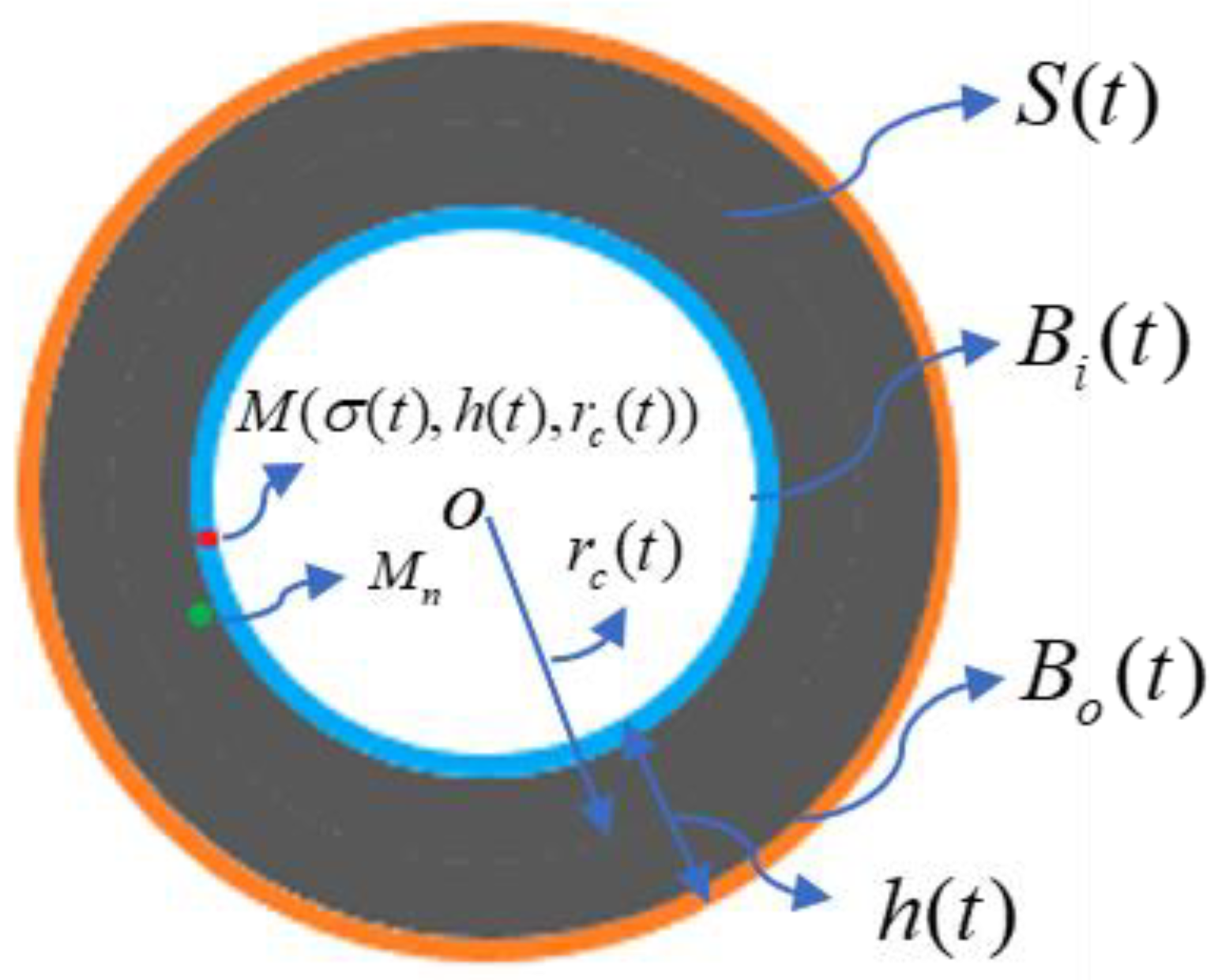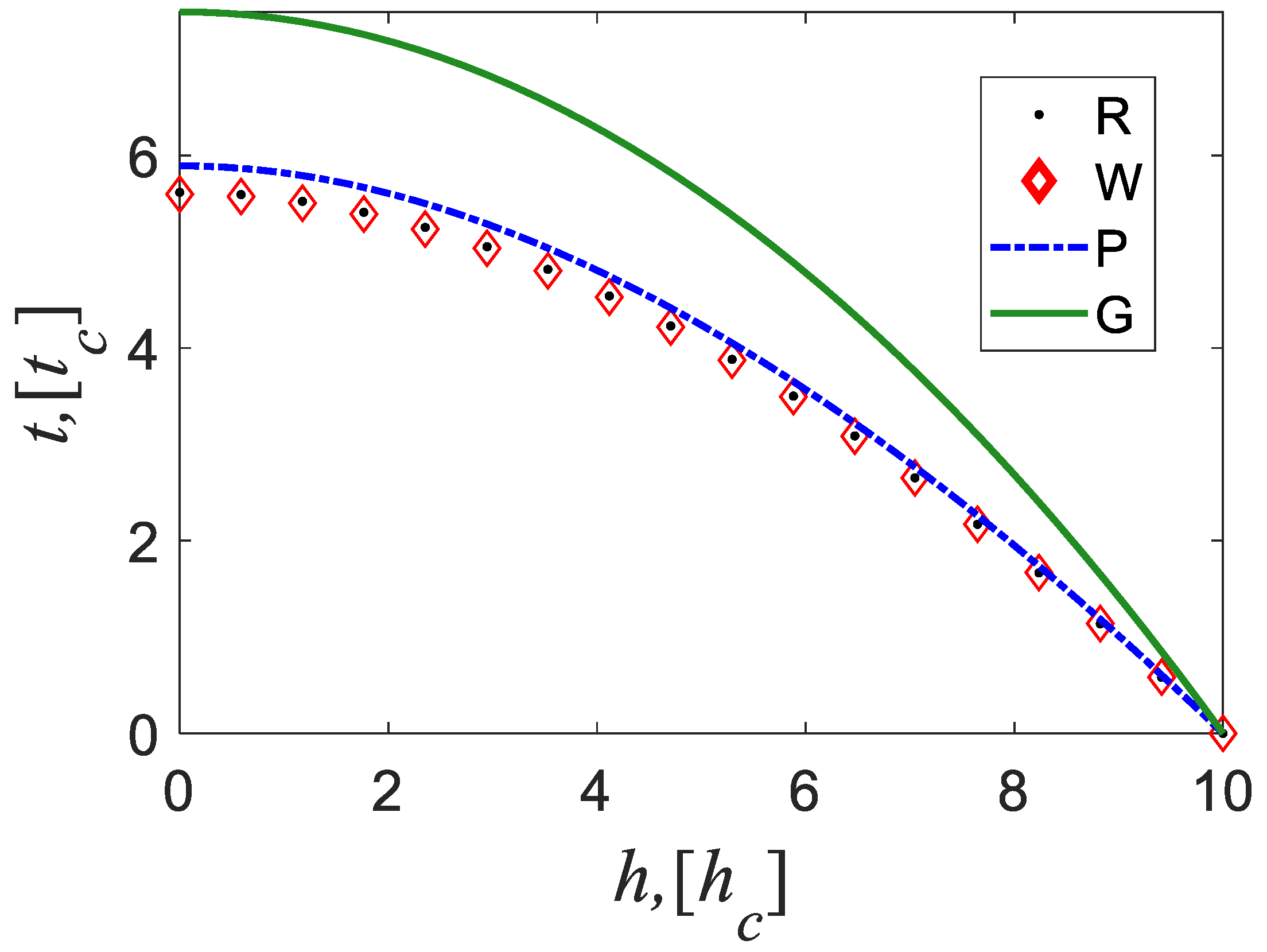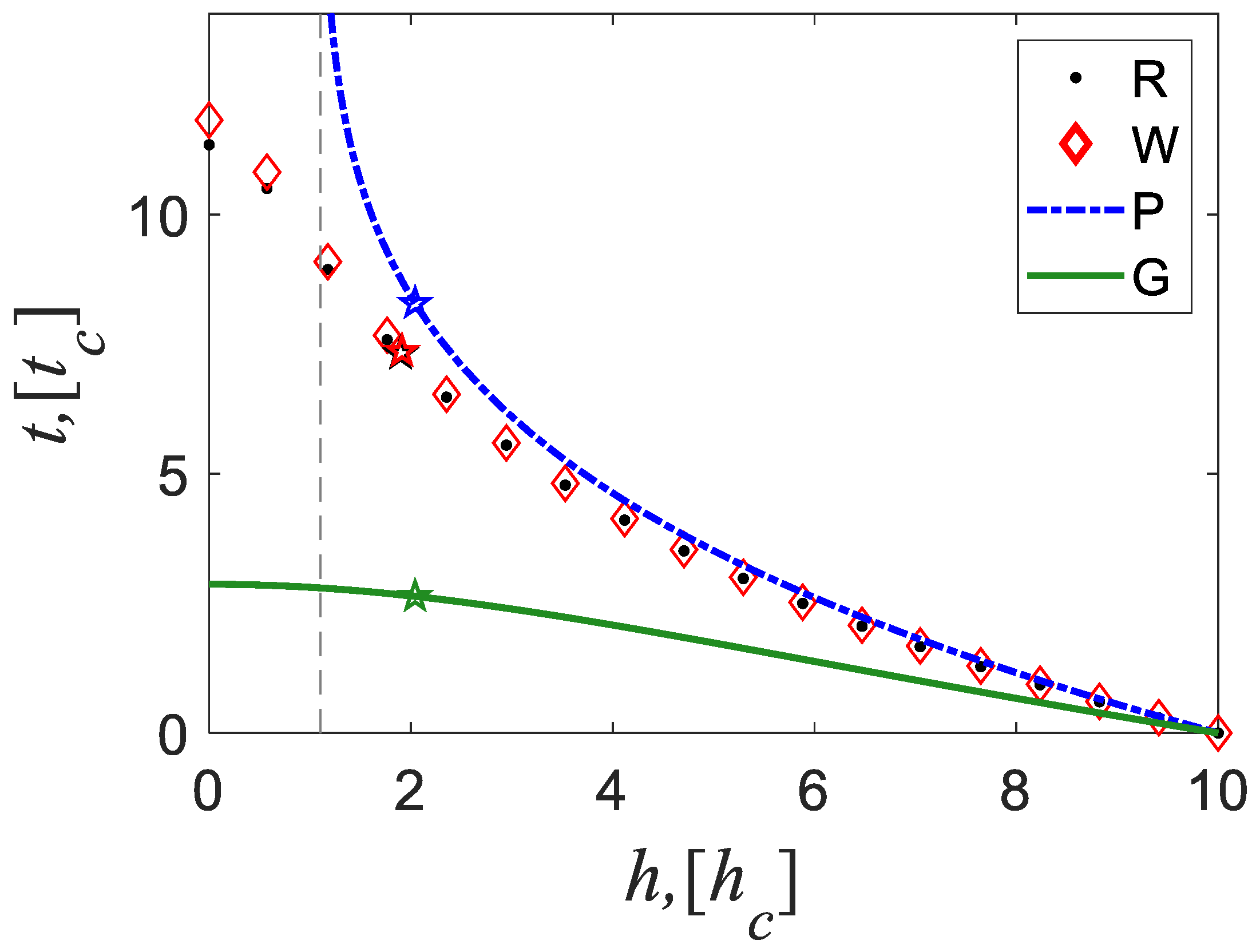Analytical Solutions and Case Studies on Stress-Dependent Corrosion in Pressurized Spherical Vessels
Abstract
:1. Introduction
1.1. Corrosion Research
1.2. Corrosion Problems of Pressure Vessels
1.2.1. Phenomenological Model
1.2.2. Experimental Research and Data
1.2.3. Theories on Corrosion Lifetime (Including Failure Criteria)
Existing Shell Stresses Distribution Equations
Analytical Relationship between Vessel Stress/Thickness and Time
Failure Criteria for Further Life Problems (or Critical Stress or Critical Thickness) and Its Assumptions
1.3. Aspects Requiring Further Analysis
- It is challenging to improve (or create a new model) the current corrosion kinetic models based on the existing amount of test data.One reason is the restricted amount of data from real engineering applications required to verify or improve the validity of those models used in the corrosion problem of pressure vessels. Another is the huge money and time cost of data collection for shells with a generally long lifetime.
- The assumptions of the stress distribution equation need to be further optimized.These simplified stress distribution equations, based on Lamé formulas or Laplace laws, are not perfect. For some, there are many assumptions, resulting in a decrease in accuracy or a narrow range of applications. Some, with few assumptions, make it difficult to obtain an analytical solution that is easy to program or friendly to engineering applications.
- Delivering difficulties of existing analytical methods.
- New applications (beyond pressure vessels) urgently need more efficient and easy-to-program analytical methods.
1.4. Suggested Improvement in Analysis of the Vessel Corrosion Problems
2. Problem Formulation
2.1. Characterization of Shell State
2.1.1. For Solving h and rc (Solution of the Problem for Stresses)
2.1.2. For Solving σ(t)
3. A New Analytical Method
3.1. Promotion of the Boundary Stress, σ
3.2. Improvement of the Vessel Thickness, h
3.3. Presentation of the Vessel Mid-Surface Radius, rc, in Time
3.4. Additional Interesting Finding
4. Case Studies
4.1. Tracking Vessel σ and (h, rc) in Special Case
4.2. Tracking the h at Point M under the General Case
4.3. Tracking Vessel Boundary, Bi, and Shape, S, under the General Case
4.4. Predicting the Shell Critical State (t*, h*)
5. Conclusions
5.1. Contributions to Engineering Applications
- (a)
- Our method achieves a global, simultaneous tracking of shell shape (thickness and midplane radius) and stress. Therefore, we generalize those existing methods, which usually provide solutions only for thickness or only for stress.
- (b)
- Relative to the existing methods, our respective analytical solutions provide the following: easy to program, no more time-consuming, operator-friendly, and more accurate.
- (c)
- Most importantly, we can obtain higher accuracy of lifetime, t*, and critical thickness, h*, in the long-term domain.
5.2. Contributions to Research Techniques in Physical Sciences
5.3. Contributions to Methods and Techniques for Solving Systems of Nonlinear Differential Equations in Mathematics
5.4. The Proposed Method Needs Further Discussion
Author Contributions
Funding
Data Availability Statement
Acknowledgments
Conflicts of Interest
Abbreviations
| A | thermal expansion coefficient of the material |
| ai | corrosion constant for internal corrosion |
| ao | corrosion constant for external corrosion |
| b | corrosion inhibition effect |
| dr | radius of two concentric spheres |
| Dθ | the angle between the plane and the positive z-axis |
| dφ | angle between the x-axis counterclockwise and the plane |
| f(x) | coefficient of the time-variant thickness-to-radius ratio |
| h, h(t) | thickness |
| h* | corresponding thickness of the shell under the critical failure state |
| ha | given minimal allowable thickness |
| mi | corrosion constant |
| mo | corrosion constant |
| pi | inner pressure |
| po | outer pressure |
| Δp | pi − po |
| r, r(t) | distance between a point in the shell material and the origin of the coordinate system |
| ro | distance between the internal surface in the shell material and the origin of the coordinate system |
| rc, rc(t), ri, ri(t), ro, ro(t) | middle (inner, outer) surface radius of the shell |
| t | time |
| t* | time required for a corroded pressure shell to fail for the first time due to buckling or yielding |
| td | time for the shell to completely dissolve |
| vi (vo) | inner (outer) mechano-chemical corrosion rate |
| x | thickness to mid-surface radius ratio, , or for spherical shell |
| stress under longitudinal or transverse forces, cylindrical shells, spherical shells, or other shells | |
| σ(rj) | principal stress; j = i, o |
| σ(rj)max | maximum principal stress |
| σe(r) | effective stress/ the equivalent stress |
| σr(r) | radial stress |
| σθ(r) | hoop stress maximum hoop or simply hoop |
| σφ(r) | meridian stress |
| (, , ) | error of h (rc, t*, h*) predicted by method M in comparison with reference method R |
| (, , ) | difference between h (rc, t*, h*) value predicted by method P and that by method W |
| shell S state | |
| () | inner (outer) boundary of shell one line |
References
- Okulova, D.D.; Almazova, L.A.; Sedova, O.S.; Pronina, Y.G. On Local Strength of a Spherical Vessel with Pits Distributed along the Equator. Frat. Integrità Strutt. 2023, 17, 70–80. [Google Scholar] [CrossRef]
- Allen, H. Corrosion Problems with Pressure Vessels. Anti Corros. Methods Mater. 1958, 5, 390–397. [Google Scholar] [CrossRef]
- King, R.T. Failure of a Low-carbon Steel Pressure Vessel from Caustic Embrittlement by Postassium Hydroxide. J. Fail. Anal. Prev. 2022, 22, 2106–2109. [Google Scholar] [CrossRef]
- Czaban, M. Aircraft Corrosion Review of Corrosion Processes and Its Effects in Selected Cases. Fatigue Aircr. Struct. 2018, 10, 5–20. [Google Scholar] [CrossRef]
- Somerday, B.P.; San Marchi, C. Effects of Hydrogen Gas on Steel Vessels and Piplelines; Brian P. Somerday and Chris San Marchi Sandia National Laboratories: Livermore, CA, USA, 2006; pp. 1–34. [Google Scholar]
- Faes, W.; Lecompte, S.; Ahmed, Z.Y. Corrosion and Corrosion Prevention in Heat Exchangers. J. Corros. Rev. 2019, 37, 131–155. [Google Scholar] [CrossRef]
- Askari, M.; Aliofkhazraei, M.; Afroukhteh, S. A Comprehensive Review on Internal Corrosion and Cracking of Oil and Gas Pipelines. Nat. Gas Sci. Eng. 2019, 71, 102971. [Google Scholar] [CrossRef]
- Hashim, N.Z.N.; Kassim, K. The Effect of Temperature on Mild Steel Corrosion in 1 M HCL by Schiff Bases. Malays. J. Anal. Sci. 2014, 18, 28–36. [Google Scholar]
- Liu, J.G.; Li, Z.; Li, Y.; Hou, B.R. Corrosion Process of D32 Steel Used for Offshore Oil Platform in Splash Zone. Anti Corros. Methods Mater. 2016, 63, 56–64. [Google Scholar] [CrossRef]
- MacLeod, I.D. Corrosion and Conservation Management of the Submarine HMAS AE2 (1915) in the Sea of Marmara, Turkey. Heritage 2019, 2, 868–883. [Google Scholar] [CrossRef]
- Yang, X.; Cheng, H. Recent Developments of Flexible and Stretchable Electrochemical Biosensors. Micromachines 2020, 11, 243. [Google Scholar] [CrossRef]
- Zhou, H.; Qin, W.; Yu, Q.; Yu, X.; Cheng, H.; Wu, H. Circumferential Buckling and Postbuckling Analysis of Thin Films Integrated on a Soft Cylindrical Substrate with Surface Relief Structures. Extrem Mech. Lett. 2020, 35, 2352–4316. [Google Scholar] [CrossRef]
- Yang, H.Q.; Zhang, Q.; Tu, S.S.; Wang, Y.; Li, Y.M.; Huang, Y. A Study on Time-Variant Corrosion Model for Immersed Steel Plate Elements Considering the Effect of Mechanical Stress. Ocean Eng. 2016, 125, 134–146. [Google Scholar] [CrossRef]
- De Meo, D.; Oterkus, E. Finite Element Implementation of a Peridynamic Pitting Corrosion Damage Model. Ocean Eng. 2017, 135, 76–83. [Google Scholar] [CrossRef]
- Cui, C.; Ma, R.; Martínez-Pañeda, E. A Phase Field Formulation for Dissolution-Driven Stress Corrosion Cracking. J. Mech. Phys. Solids 2021, 147, 104254–104275. [Google Scholar] [CrossRef]
- Kristensen, P.K.; Niordson, C.F.; Martínez-Pañeda, E. An Assessment of Phase Field Fracture: Crack Initiation and Growth. Philos. Trans. R Soc. A Math. Phys. Eng. Sci. 2021, 379, 2203–2245. [Google Scholar] [CrossRef]
- Al-Badour, F.A.; Adesina, A.Y.; Ibrahim, A.B.; Suleiman, R.K.; Merah, N.; Sorour, A.A. Electrochemical Investigation of the Effect of Process Parameters on the Corrosion Behavior of Aluminum-cladded Pressure Vessel Steel Using a Friction Stir Diffusion Cladding Process. Metals 2020, 10, 623. [Google Scholar] [CrossRef]
- Kristensen, P.K.; Niordson, C.F.; Martínez-Pañeda, E. Applications of Phase Field Fracture in Modelling Hydrogen Assisted Failures. Theor. Appl. Fract. Mech. 2020, 110, 102837. [Google Scholar] [CrossRef]
- Ilyin, A.; Pronina, Y.G. Internal Stress-assisted Corrosion of a Toroidal Shell under Pressure. Procedia Struct. Integr. 2023, 47, 290–295. [Google Scholar] [CrossRef]
- Jivkov, A.P. Deformation-Promoted Nucleation of Corrosion Cracks: State, Problems and Perspectives. Annu. Univ. Archit. 2003, 44, 97–144. [Google Scholar]
- Gutman, E.M.; Zainullin, R.S.; Zaripov, R.A. Kinetics of Mechanicochemical Failure and the Life of Constructional Elements in Tension in Elastoplastic Deformations. Sov. Mater. Sci. 1984, 20, 101–103. [Google Scholar] [CrossRef]
- Akimov, G.V. Fundamentals of the Corrosion Theory and Metal Protection; Metallurgizdat: Moscow, Russia, 1964; pp. 24–56. [Google Scholar]
- Dolinskii, V.M. Calculations on Loaded Tubes Exposed to Corrosion. Chem. Pet. Eng. 1967, 3, 96–97. [Google Scholar] [CrossRef]
- Kabrits, S.; Kolpak, E. Nonlinear Axisymmetric Deformation of Compound Shells of Revolution under Conditions of Mechanochemical Corrosion. Procedia Struct. Integr. 2023, 47, 513–520. [Google Scholar] [CrossRef]
- Gutman, E.M.; Zainullin, R.S.; Zaripov, R.A. The Life of High-pressure Vessels under Conditions of Mechanicochemical Corrosion. In Corrosion and Protection in the Petroleum and Gas Industry; Vsesoyuz. Nauch. Isled. Inst. Org.: Promysh, Russia, 1977; pp. 3–5. [Google Scholar]
- Gutman, E.M. The Mechanical Chemistry of Metals and Protection from Corrosion; Metallurgiya: Moscow, Russia, 1981; pp. 90–120. [Google Scholar]
- Gutman, E.M. Mechanochemistry of Solid Surfaces. In Mechanochemistry of Solid Surfaces; World Scientific: Singapore, 1994; pp. 1–80. [Google Scholar]
- Elishakoff, I.; Ghyselinck, G.; Miglis, Y. Durability of an Elastic Bar under Tension with Linear or Nonlinear Relationship between Corrosion Rate and Stress. Appl. Mech. Trans. ASME 2012, 79, 021013. [Google Scholar] [CrossRef]
- Pavlov, P.A.; Malibekov, A.K. Multicycle Fatigue of Carbon Steels. Strength Mater. 1987, 8, 41–45. [Google Scholar]
- Pronina, Y.; Sedova, O. Analytical Solution for the Lifetime of a Spherical Shell of Arbitrary Thickness under the Pressure of Corrosive Environments: The Effect of Thermal and Elastic Stresses. J. Appl. Mech. 2021, 88, 61004–61013. [Google Scholar] [CrossRef]
- Pronina, Y.G. Analytical Solution for Decelerated Mechanochemical Corrosion of Pressurized Elastic-perfectly Plastic Thick-walled Spheres. Corros. Sci. 2015, 90, 161–167. [Google Scholar] [CrossRef]
- Gutman, E.M.; Bergman, R.M.; Levitsky, S.P. Influence of Internal Uniform Corrosion on Stability Loss of a Thin-walled Spherical Shell Subjected to External Pressure. Corros. Sci. 2016, 111, 212–215. [Google Scholar] [CrossRef]
- Gutman, E.M. An inconsistency in Film Rupture Model of Stress Corrosion Cracking. Corros. Sci. 2007, 49, 2289–2302. [Google Scholar] [CrossRef]
- Gutman, E.; Haddad, J.; Bergman, R. Stability of Thin-walled High-pressure Vessels Subjected to Uniform Corrosion. Thin Walled Struct. 2000, 38, 43–52. [Google Scholar] [CrossRef]
- Gutman, E.M.; Haddad, J.; Bergman, R. Stability of Thin-walled High-pressure Cylindrical Pipes with Non-circular Cross-section and Variable Wall Thickness Subjected to Non-homogeneous Corrosion. Thin Walled Struct. 2005, 43, 23–32. [Google Scholar] [CrossRef]
- Bergman, R.M.; Levitsky, S.P.; Haddad, J.; Gutman, E.M. Stability Loss of Thin-walled Cylindrical Tubes, Subjected to Longitudinal Compressive Forces and External Corrosion. Thin Walled Struct. 2006, 44, 726–729. [Google Scholar] [CrossRef]
- Liu, H.; Yuan, H.; Zhang, W. Time-varied Stability Loss of Uniformly Compressed Hemispherical Shells Subjected to Uniform Corrosion Based on the Southwell Procedure. In Proceedings of the IASS Annual Symposia, Boston, MA, USA, 16–20 July 2018; pp. 1–8. [Google Scholar]
- Vukelic, G.; Vizentin, G. Composite Wrap Repair of a Failed Pressure Vessel—Experimental and Numerical Analysis. Thin Walled Struct. 2021, 169, 108488. [Google Scholar] [CrossRef]
- Pronina, Y.; Sedova, O.; Grekov, M.; Sergeeva, T. On Corrosion of a Thin-walled Spherical Vessel under Pressure. Int. J. Eng. Sci. 2018, 130, 115–128. [Google Scholar] [CrossRef]
- Alfutov, N.A. Stability of Shells. In Stability of Elastic Structures. Foundations of Engineering Mechanics; Springer: Berlin, Germany, 2000; pp. 221–285. [Google Scholar]
- Liu, C.H.; Lacidogna, G. A Non-Destructive Method for Predicting Critical Load, Critical Thickness and Service Life for Corroded Spherical Shells under Uniform External Pressure Based on NDT Data. Appl. Sci. 2023, 13, 4172. [Google Scholar] [CrossRef]
- Timoshenko, S.P.; Gere, J.M. Theory of Elastic Stability; Dover Publications: New York, NY, USA, 2009. [Google Scholar]
- Volʹmir, A.S. Stability of Deformable Systems; Fizmatlit: Moscow, Russia, 1970. [Google Scholar]
- Pronina, Y.G.; Sedova, O.S.; Kabrits, S.A. On the Applicability of Thin Spherical Shell Model for the Problems of Mechanochemical Corrosion. AIP Conf. Proc. 2015, 1648, 300008. [Google Scholar]
- Campbell, D.K. Nonlinear Physics: Fresh Breather. Nature 2004, 432, 455–456. [Google Scholar] [CrossRef]
- Jordan, D.W.; Smith, P. Nonlinear Ordinary Differential Equations. Math. Gaz. 1979, 63, 1–66. [Google Scholar]
- Lazard, D. Thirty Years of Polynomial System Solving, and Now? Symb. Comput. 2009, 44, 222–231. [Google Scholar] [CrossRef]








| Value | 0.6 | 13.3 | 70.0 | 12.7 |
| Value | 0.8 | 7.6 | 7.6 | 6.8 |
Disclaimer/Publisher’s Note: The statements, opinions and data contained in all publications are solely those of the individual author(s) and contributor(s) and not of MDPI and/or the editor(s). MDPI and/or the editor(s) disclaim responsibility for any injury to people or property resulting from any ideas, methods, instructions or products referred to in the content. |
© 2023 by the authors. Licensee MDPI, Basel, Switzerland. This article is an open access article distributed under the terms and conditions of the Creative Commons Attribution (CC BY) license (https://creativecommons.org/licenses/by/4.0/).
Share and Cite
Liu, C.H.; Lacidogna, G. Analytical Solutions and Case Studies on Stress-Dependent Corrosion in Pressurized Spherical Vessels. Metals 2023, 13, 1918. https://doi.org/10.3390/met13121918
Liu CH, Lacidogna G. Analytical Solutions and Case Studies on Stress-Dependent Corrosion in Pressurized Spherical Vessels. Metals. 2023; 13(12):1918. https://doi.org/10.3390/met13121918
Chicago/Turabian StyleLiu, Cheng Huijuan, and Giuseppe Lacidogna. 2023. "Analytical Solutions and Case Studies on Stress-Dependent Corrosion in Pressurized Spherical Vessels" Metals 13, no. 12: 1918. https://doi.org/10.3390/met13121918






